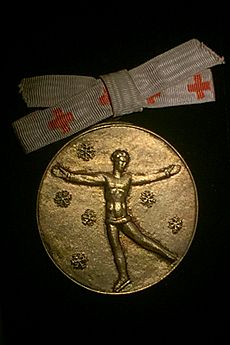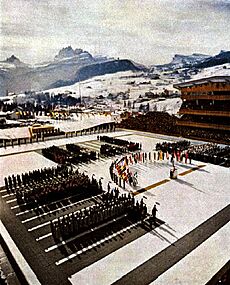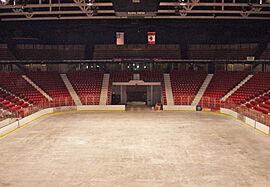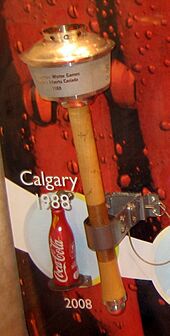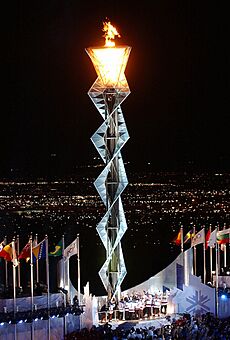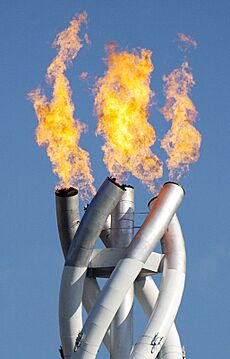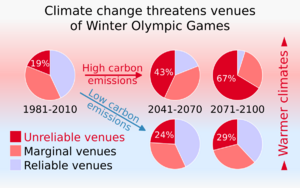Winter Olympic Games facts for kids
Quick facts for kids Winter Olympic Games |
|
|---|---|

The Olympic flame in Beijing during the 2022 Winter Olympics
|
The Winter Olympic Games, also known as the Winter Olympics, is a huge international sports event. It happens every four years and features sports played on snow and ice. The very first Winter Olympics took place in Chamonix, France, in 1924.
The idea for the modern Olympic Games came from the ancient Olympic Games held in Olympia, Greece, a very long time ago. Many years later, in 1894, a Frenchman named Baron Pierre de Coubertin started the International Olympic Committee (IOC). This led to the first modern Summer Olympic Games in Athens, Greece, in 1896. The IOC is the main group that runs the Olympic Games.
The first Winter Olympics had five main sports with nine different events. These included bobsleigh, curling, ice hockey, Nordic skiing (like cross-country skiing and ski jumping), and skating (like figure skating and speed skating).
The Games happened every four years from 1924 to 1936. They were paused in 1940 and 1944 because of World War II. They started again in 1948. For a long time, the Summer and Winter Olympics were held in the same year. But in 1986, the IOC decided to change this. Now, they happen in different even-numbered years, two years apart. For example, the 1992 Winter Olympics were the last to be in the same year as the Summer Games. The next Winter Games were moved up to 1994, and then the regular four-year cycle continued from 1998.
The Winter Olympics have changed a lot over time. New sports and events have been added. Some, like alpine skiing, luge, short track speed skating, freestyle skiing, skeleton, and snowboarding, are now regular parts of the Games. Some sports, like curling and bobsleigh, were stopped and then brought back. Others, like military patrol, were removed for good, though biathlon is a modern version of it.
Television has helped the Games become very popular around the world. This also brings in money from selling broadcast rights and advertising. This money is very important for the IOC. Sometimes, there have been challenges, like issues with how the host city was chosen or problems with athletes using banned substances. Countries have also used the Games to show off their political systems.
The Winter Olympics have been held in thirteen countries across three continents. All these countries are in the Northern Hemisphere. The United States has hosted four times (1932, 1960, 1980, and 2002). France has hosted three times (1924, 1968, and 1992). Several other countries, like Switzerland, Austria, Norway, Japan, Italy, and Canada, have hosted twice. Other countries, like Germany and China, have hosted once.
The Italian cities of Milan and Cortina d'Ampezzo will host the 2026 Winter Olympics. The Winter Olympics usually happen in February. No city in the Southern Hemisphere has ever hosted the Winter Olympics.
As of 2022, twelve countries have been in every Winter Olympic Games. These include Austria, Canada, Finland, France, Great Britain, Hungary, Italy, Norway, Poland, Sweden, Switzerland, and the United States. Six of these countries have won medals at every Games: Austria, Canada, Finland, Norway, Sweden, and the United States. The United States is the only country to have won a gold medal at every Winter Olympics. Norway has won the most medals overall in the Winter Olympics.
Contents
History of the Winter Olympics
How the Winter Games Started
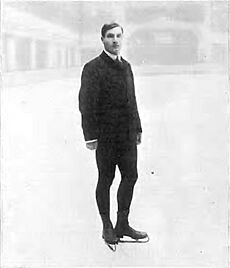
Before the Winter Olympics, there were events called the Nordic Games. These were started in Sweden in 1901 by General Viktor Gustaf Balck. He was a friend of Pierre de Coubertin, who founded the Olympics. Balck tried to get winter sports, especially figure skating, added to the Olympics. He finally succeeded at the 1908 Summer Olympics in London, where four figure skating events were held.
Later, in 1911, an Italian count suggested having a week of winter sports as part of the 1912 Summer Olympics in Sweden. But the organizers said no because they wanted to protect the Nordic Games.
The idea came up again for the 1916 Summer Olympics in Germany. A "winter sports week" was planned with speed skating, figure skating, ice hockey, and Nordic skiing. However, the 1916 Olympics were canceled because World War I started.
The First Winter Olympics: 1920 to 1936
After World War I, the 1920 Summer Olympics in Belgium included figure skating and ice hockey. Countries like Germany were not allowed to compete. The next year, the IOC decided that France, which was hosting the 1924 Summer Olympics, would also host a separate "International Winter Sports Week." Chamonix was chosen for this event.
The 1924 Games in Chamonix were a big success! More than 250 athletes from 16 countries competed. Athletes from Finland and Norway won many medals. The first gold medal ever was won by Charles Jewtraw from the United States in speed skating. Sonja Henie from Norway, who was only 11 years old, competed in figure skating. She finished last but became very popular.
In 1925, the IOC officially decided to create a separate winter event. The 1924 Games in Chamonix were then officially called the "First Winter Olympics."
St. Moritz, Switzerland, hosted the second Winter Games in 1928. The weather was tricky, with a blizzard at the start and then warm weather. This caused some events, like the 10,000-meter speed skating, to be canceled. Sonja Henie of Norway returned and won the ladies' figure skating at age 15. She was the youngest Olympic champion for 70 years and won her title again in the next two Olympics.
The next Winter Olympics were held in Lake Placid, New York, United States. This was the first time the Games were outside Europe. Fewer athletes came because the trip was long and expensive during the Great Depression. There wasn't much snow at first, but enough fell later for the events. Sonja Henie won her second gold medal. Eddie Eagan from the United States, who had won a boxing gold medal in the Summer Olympics in 1920, won gold in men's bobsleigh. He is the only person to win gold medals in different sports at both the Summer and Winter Olympics.
The German towns of Garmisch-Partenkirchen hosted the 1936 Winter Olympics. This was the last time the Summer and Winter Olympics were held in the same country in the same year. Alpine skiing was added, but ski teachers were not allowed to compete because they were considered professionals. Because of this, skiers from Switzerland and Austria refused to compete.
World War II stopped the Winter Olympics. The 1940 Games were supposed to be in Japan but were canceled. The 1944 Games in Italy were also canceled due to the war.
Winter Olympics: 1948 to 1962
St. Moritz in Switzerland was chosen to host the first post-war Games in 1948. Switzerland had stayed neutral during the war, so its venues were ready. It was the first city to host the Winter Olympics twice. Germany and Japan were not invited. There was a lot of excitement, and 10 countries won gold medals, which was a record at the time.
The Olympic Flame tradition started at the 1952 Games in Oslo, Norway. The flame was lit by a Norwegian skiing pioneer, and the first torch relay for the Winter Games was done by skiers. Norwegian athletes won the most medals.
After not being able to host in 1944, Cortina d'Ampezzo in Italy hosted the 1956 Winter Olympics. The final torchbearer at the opening ceremony fell but managed to light the cauldron. These were the first Winter Games to be shown on television.
The Soviet Union joined the Olympics for the first time and quickly won many medals. This was partly because they had "full-time amateur athletes" who were paid by the state to train. Chiharu Igaya won the first Winter Olympics medal for Japan and Asia.
The IOC chose Squaw Valley, United States, for the 1960 Winter Olympics. This was a surprise because the area was not developed. About $80 million was spent to build everything needed. The opening and closing ceremonies were created by Walt Disney Company. These Games were the first to have a special village for athletes and the first to use a computer to count results. Women's speed skating events were also added. Bobsleigh was not held because not enough countries signed up, and building a track was too expensive.
Winter Olympics: 1964 to 1980
The Austrian city of Innsbruck hosted the Games in 1964. The Olympic torch for the Winter Games was lit in Olympia, Greece, for the first time. Even though Innsbruck was a winter sports place, there wasn't enough snow. The Austrian army had to bring snow and ice from other areas. Soviet speed-skater Lidia Skoblikova won all four speed skating events, setting a record for Winter Olympics athletes. Luge was added to the Olympic program, but a competitor died in a practice run before the Games.
The 1968 Winter Olympics in Grenoble, France, were the first to be shown in color on TV. Over 1,100 athletes from 37 countries competed. French alpine ski racer Jean-Claude Killy won all the men's alpine skiing events. The TV rights were sold for a lot of money. The organizers spread the events out to save money, which meant building three Olympic Villages.
The 1972 Winter Games in Sapporo, Japan, were the first outside North America or Europe. There was a discussion about whether some alpine skiers were professionals, which was against the rules then. Only Austrian Karl Schranz was not allowed to compete. Canada did not send ice hockey teams in 1972 and 1976 because they wanted to use professional players, which was not allowed. Francisco Fernández Ochoa became the first and only Spaniard to win a Winter Olympic gold medal in slalom.
The 1976 Winter Olympics were first planned for Denver, USA. But the city decided not to host because of rising costs. The IOC then asked Innsbruck to host, and they accepted. Innsbruck had hosted before, so they had the venues ready. Two cauldrons were lit at the opening ceremony because it was Innsbruck's second time hosting. The Soviet Union won its fourth straight ice hockey gold medal.
In 1980, the Winter Olympics returned to Lake Placid, USA. Cyprus and Costa Rica made their Olympic debuts. The People's Republic of China also competed for the first time since 1952.
American speed-skater Eric Heiden won five gold medals, setting Olympic or World records in every event he competed in. Hanni Wenzel won two gold medals, making Liechtenstein the smallest nation to have an Olympic gold medalist. In the "Miracle on Ice", the American hockey team of college players beat the strong Soviet Union team and went on to win gold.
Winter Olympics: 1984 to 1998
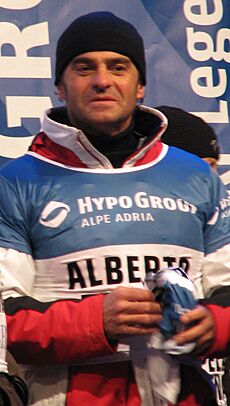
Sarajevo, Yugoslavia, was a surprise choice to host the 1984 Winter Olympics. The Games were well-organized. Yugoslavia won its first Olympic medal when Jure Franko won silver in alpine skiing. British ice dancers Jayne Torvill and Christopher Dean won gold with perfect scores for their Boléro routine.
In 1988, Calgary, Canada, hosted the first Winter Olympics that lasted 16 days. New events were added, and future Olympic sports like curling and short track speed skating were shown as demonstration sports. Speed skating events were held indoors for the first time. Dutch skater Yvonne van Gennip won three gold medals and set two world records.
Finnish ski jumper Matti Nykänen also won three gold medals. Alberto Tomba, an Italian skier, won two gold medals. East German Christa Luding-Rothenburger won gold in speed skating and then a silver in track cycling at the Summer Games in the same year. The 1988 Games are remembered for films like Cool Runnings about the Jamaican bobsled team and Eddie the Eagle about British ski jumper Michael Edwards.
The 1992 Winter Games were the last to be held in the same year as the Summer Games. They were in the French Savoie region. Germany competed as one nation for the first time since 1964. New countries like Croatia and Slovenia made their debuts. Finnish ski jumper Toni Nieminen, at 16, became the youngest male Winter Olympic champion. New Zealand skier Annelise Coberger became the first Winter Olympic medalist from the Southern Hemisphere.
The 1994 Winter Olympics in Lillehammer, Norway, were the first Winter Games held in a different year from the Summer Games. This was due to the IOC's decision to separate them. Lillehammer is the northernmost city to host the Winter Games. It was the second time Norway hosted. The Olympic Truce was observed for the first time. The Czech Republic and Slovakia made their Olympic debuts.
The women's figure skating competition got a lot of media attention due to an incident involving American skaters Nancy Kerrigan and Tonya Harding. Both competed, but Oksana Baiul of Ukraine won gold. Johann Olav Koss of Norway won three gold medals in speed skating.
13-year-old Kim Yoon-Mi became the youngest Olympic gold medalist when South Korea won the women's speed skating relay. Bjørn Dæhli of Norway won many medals in cross-country skiing. Russia won the most gold medals. The IOC president called Lillehammer "the best Olympic Winter Games ever."
The 1998 Winter Olympics in Nagano, Japan, were the first to have over 2,000 athletes. Professional players from the National Hockey League played in the men's ice hockey tournament for the first time, and the Czech Republic won. Women's ice hockey also debuted, with the United States winning gold. Bjørn Dæhlie of Norway became the most decorated Winter Olympic athlete with eight gold medals. Tara Lipinski of the United States, at 15, became the youngest female gold medalist in an individual event. New world records were set in speed skating because of new skate technology.
Winter Olympics: 2002 to 2022
After some issues with how the host city was chosen, the 2002 Winter Olympics were held in Salt Lake City, United States. Nearly 2,400 athletes from 77 countries competed. These Games happened after the September 11 attacks, so security was very high. The opening ceremony honored those affected by the attacks.
German Georg Hackl won a silver medal in luge, becoming the first athlete to win medals in the same event in five straight Olympics. Canada won both the men's and women's ice hockey gold medals. There was a controversy in pairs figure skating judging, which led to both the Canadian and Russian pairs being awarded gold medals. Australian Steven Bradbury became the first gold medalist from the Southern Hemisphere in short-track speed skating.
The Italian city of Turin hosted the 2006 Winter Olympics. South Korean athletes won 10 medals in short-track speed skating. In cross-country skiing, Canadian Sara Renner broke a pole, and a Norwegian coach lent her one. This helped her team win a silver medal.
Kjetil-Andre Aamodt of Norway became the most decorated ski racer with 4 gold and 8 total medals. He is also the only ski racer to win the same event at three Olympics. Claudia Pechstein of Germany became the first speed skater to earn nine career medals.
In 2003, the IOC chose Vancouver, Canada, to host the 2010 Winter Olympics. Vancouver is the largest city to host the Winter Games. Over 2,500 athletes from 82 countries participated. Sadly, Georgian luger Nodar Kumaritashvili died in a training run on the opening day, leading to safety changes on the track.
Norwegian cross-country skier Marit Bjørgen won five medals. For the first time, Canada won a gold medal at an Olympic Games it hosted. The Canadian team finished first in gold medals, setting a new record for a country at a single Winter Olympics with 14 golds.
The Russian team did not perform as well as expected in Vancouver. This led to calls for changes in their sports programs. Asian countries, however, had a very successful Games, winning many medals. This increased the chances of an Asian city hosting the next Winter Olympics.
Sochi, Russia, hosted the 2014 Winter Olympics. This was Russia's first time hosting a Winter Olympics. A record 2,800 athletes from 88 countries competed. The Games were very expensive.
On the snow, Norwegian biathlete Ole Einar Bjørndalen won two golds, becoming the most decorated Winter Olympian ever with 13 medals. Another Norwegian, cross-country skier Marit Bjørgen, won three golds. Snowboarder Ayumu Hirano became the youngest medalist on snow at 15.
On the ice, the Netherlands team was very strong in speed skating, winning 23 medals. Ireen Wüst was their most successful skater. In figure skating, Yuzuru Hanyu became the first skater to score over 100 points in the short program. Luger Armin Zöggeler won a bronze, becoming the first Winter Olympian to win a medal in six straight Games.
After their performance in 2010, Russia invested a lot in sports and initially topped the medal table in 2014. However, later investigations found issues with some Russian athletes' samples. This led to some athletes being disqualified and medals being re-awarded.
Pyeongchang, South Korea, hosted the 2018 Winter Olympics. This was South Korea's first Winter Olympics. Over 2,900 athletes from 92 countries participated.
Before the 2018 Games, there were tensions between North and South Korea. However, North Korea agreed to participate, march with South Korea at the opening ceremony, and have a unified team in women's ice hockey. Russian athletes who met strict rules were allowed to compete as "Olympic Athletes from Russia."
New events were added, like big air snowboarding and mixed doubles curling. The Netherlands again dominated speed skating. On the snow, Norway led in cross-country skiing. Marit Bjørgen won more medals, bringing her total to fifteen, the most by any athlete in Winter Olympics history. Johannes Høsflot Klæbo of Norway became the youngest male to win cross-country skiing gold at 21. Noriaki Kasai of Japan became the first athlete to compete in eight Winter Olympics. Ester Ledecká of the Czech Republic won gold in both skiing and snowboarding, becoming the first woman to win gold in two sports at one Winter Games.
Norway led the total medal standings with 39 medals, the highest ever for a nation at a Winter Olympics. South Korea won its highest number of medals at a Winter Olympics.
Beijing, China, hosted the 2022 Winter Olympics. Beijing became the first city to host both the Summer and Winter Olympics. Due to the COVID-19 pandemic, there were strict health rules. The Games had a record 109 events and used only renewable energy. Some events faced very cold temperatures and strong winds.
The first gold medal was won by Therese Johaug of Norway in cross-country skiing. She won two more gold medals. In women's snowboard cross, Lindsey Jacobellis of the United States won gold, 16 years after falling in the 2006 Games. The Netherlands won six gold medals in speed skating. Irene Schouten won three distances. Nils van der Poel of Sweden set new Olympic records in men's speed skating.
There was a situation with Kamila Valieva of Russia in figure skating. She was allowed to compete despite a failed test, but did not win an individual medal. Her team's gold medal was later re-allocated after an investigation. Finland won its first ice hockey gold medal. Norway was first in the overall medal standings, winning 37 medals and a record 16 gold medals.
Future Winter Olympics
The 2026 Winter Olympics will be held in Milan and Cortina d'Ampezzo, Italy. The 2030 Winter Olympics will be hosted by France in the French Alps. The 2034 Winter Olympics will be hosted by the United States in Salt Lake City, which hosted before in 2002.
Challenges and Changes
Choosing Host Cities
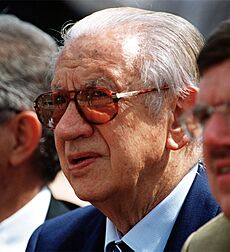
Choosing which city hosts the Olympics has sometimes faced issues. After Salt Lake City was chosen for the 2002 Games, it was found that organizers had offered gifts to IOC officials. These gifts included medical care and scholarships. Even the IOC president received gifts.
An investigation found similar issues with bids for other Olympics. While nothing was strictly illegal, the IOC worried that companies sponsoring the Games would lose trust. This led to changes: 10 IOC members were removed, and new rules were made. Now, there are limits on gifts, and more former Olympic athletes are part of the committee.
What Happens After the Games?
Hosting the Winter Olympics is very expensive. Most host cities do not make a profit. For example, the 2006 Winter Olympics in Turin, Italy, cost $3.6 billion. The 1998 Winter Olympics in Nagano, Japan, cost $12.5 billion, partly because of a new bullet train line.
Organizers hope that hosting the Games will help the local economy for years. While Nagano saw a boost for a year or two, the long-term benefits were not as big as hoped. Cities worry about being left with unused sports venues and high upkeep costs.
The Winter Olympics also need mountains for alpine events. This means venues often have to be built in less populated areas. These areas might not need large arenas or many hotels after the Games. Because of these costs, fewer cities want to host. The IOC has tried to help by funding part of the budget and requiring cities to have a "legacy plan" for long-term benefits.
Starting with the 2022 Winter Olympics, the IOC allows alpine events to be held further away from the main host city. For example, Beijing's venues were 220 km away from the city. For the 2026 Games, Milan and Cortina d'Ampezzo are 410 km apart.
Fair Play and Rules
In 1967, the IOC started testing athletes for banned substances. The first Winter Games athlete to test positive was a West German hockey player in 1972. Over time, testing became more common and standardized. In 1999, the IOC created the World Anti-Doping Agency (WADA) to fight against performance-enhancing drugs.
The 2006 Winter Olympics in Turin had a scandal involving "blood doping," where athletes try to improve oxygen flow. Police raided the Austrian cross-country ski team's residence and found equipment.
The 2014 Winter Olympics in Sochi also had issues with some Russian athletes' samples. This led to investigations and some athletes being disqualified.
Countries and Competition
The Winter Olympics became a place for countries to show off their strengths, especially during the Cold War when the Soviet Union first joined in 1956. Countries from the Eastern Bloc had "full-time amateur athletes" who were paid by the state to train. This gave them an advantage over Western athletes who paid for their own training. The IOC kept amateur rules until the 1990s.
The relationship between East and West Germany was also tricky. Germany was not allowed to compete in 1948. Later, the IOC wanted East and West Germany to compete as one team. This continued until the 1968 Games when the IOC allowed them to compete as separate teams.
Boycotts and Changes
The Winter Games have only had one national team boycott. Taiwan decided not to participate in the 1980 Winter Olympics in Lake Placid. Before the Games, the IOC allowed China to compete for the first time since 1952. China was called the "People's Republic of China" and used its own flag and anthem. Taiwan had been competing as the "Republic of China." The IOC asked Taiwan to change its name and flag, which Taiwan refused.
When Taiwanese athletes arrived with their old identification, they were not allowed in. They left the Olympics in protest. Taiwan returned to the Olympics in 1984 as "Chinese Taipei" and agreed to use a different flag and anthem. This agreement is still in place today.
Winter Olympic Sports
The Olympic Charter says winter sports must be played on "snow or ice." Since 1992, many new sports have been added, like short-track speed skating, snowboarding, and freestyle skiing. These new events have made the Winter Olympics popular in more parts of the world. While countries like Norway and Germany are still strong in traditional winter sports, countries like South Korea, Australia, and Canada are doing well in the newer sports. This means more countries are winning medals, and more people around the world are interested in the Winter Olympics.
Current Sports
| Sport | Years | Events | Events list |
|---|---|---|---|
| Alpine skiing | Since 1936 | 11 | Men's: downhill, super G, giant slalom, slalom, alpine combined. Women's: downhill, super G, giant slalom, slalom, alpine combined. Mixed parallel slalom. |
| Biathlon | Since 1960 | 11 | Men's: sprint 10 km, individual 20 km, pursuit 12.5 km, mass start 15 km, relay 4×7.5 km. Women's: sprint 7.5 km, individual 15 km, pursuit 10 km, mass start 12.5 km, relay 4×6 km. Mixed relay 4×6 km. |
| Bobsleigh | 1924-1956, since 1964 | 4 | Men's: four-man race, two-man race. Women's: two-woman race, monobob race. |
| Cross-country skiing | Since 1924 | 12 | Men's: sprint, team sprint, 15 km, 30 km skiathlon, 50 km mass start, 4×10 km relay. Women's: sprint, team sprint, 10 km, 15 km skiathlon, 30 km mass start, 4×5 km relay. |
| Curling | 1924, since 1998 | 3 | Men's, women's and mixed doubles tournaments. |
| Figure skating | Since 1924 | 5 | Men's singles. Women's singles. Pairs. Ice dancing. Team event. |
| Freestyle skiing | Since 1992 | 13 | Men's: aerials, moguls, ski cross, halfpipe, big air, slopestyle. Women's: aerials, moguls, ski cross, halfpipe, big air, slopestyle. Mixed aerials. |
| Ice hockey | Since 1924 | 2 | Men's and women's tournaments. |
| Luge | Since 1964 | 4 | Men's singles, Women's singles, Men's doubles, Women's doubles, mixed team relay. |
| Nordic combined | Since 1924 | 3 | Men's 10 km individual normal hill, 10 km individual large hill, team 4×5 km large hill. |
| Short track speed skating | Since 1992 | 9 | Men's: 500 m, 1000 m, 1500 m, 5000 m relay. Women's: 500 m, 1000 m, 1500 m, 3000 m relay. Mixed 2000 m relay. |
| Skeleton | 1928, 1948, Since 2002 | 2 | Men's and women's events. |
| Ski jumping | Since 1924 | 5 | Men's: individual normal hill, individual large hill, team large hill. Women's: individual normal hill. Mixed team normal hill. |
| Ski mountaineering | 2026 | 3 | Men's sprint. Women's sprint. Mixed relay. |
| Snowboarding | Since 1998 | 11 | Men's: snowboard cross, parallel, half-pipe, slopestyle, big air. Women's: snowboard cross, parallel, half-pipe, slopestyle, big air. Mixed snowboard cross. |
| Speed skating | Since 1924 | 14 | Men's: 500 m, 1000 m, 1500 m, 5000 m, 10,000 m, mass start, team pursuit. Women's 500 m, 1000 m, 1500 m, 3000 m, 5000 m, mass start, team pursuit. |
Demonstration Sports: What Are They?
Demonstration sports were events held at the Olympics to show off popular local sports. They didn't give out medals. This practice stopped after the 1992 Winter Olympics. For example, military patrol, which is like modern biathlon, was a medal sport in 1924 and then a demonstration sport later. Other demonstration sports included Bandy (a type of hockey), Ice stock sport (like curling), ski ballet, Skijöring (skiing behind dogs), and a sled-dog race.
Winter Olympics Medal Table
This table shows the total medals won by countries in the Winter Olympics.
Defunct nation
| No. | Nation | Gold | Silver | Bronze | Total | Games |
|---|---|---|---|---|---|---|
| 1 | 148 | 134 | 123 | 405 | 24 | |
| 2 | 114 | 121 | 95 | 330 | 24 | |
| 3 | 104 | 98 | 65 | 267 | 13 | |
| 4 | 78 | 57 | 59 | 194 | 9 | |
| 5 | 77 | 72 | 76 | 225 | 24 | |
| 6 | 71 | 88 | 91 | 250 | 24 | |
| 7 | 65 | 51 | 60 | 176 | 24 | |
| 8 | 63 | 47 | 58 | 168 | 24 | |
| 9 | 53 | 49 | 45 | 147 | 22 | |
| 10 | 47 | 39 | 35 | 121 | 6 | |
| 11 | 45 | 65 | 65 | 175 | 24 | |
| 12 | 42 | 43 | 56 | 141 | 24 | |
| 13 | 41 | 42 | 55 | 138 | 24 | |
| 14 | 39 | 36 | 35 | 110 | 6 | |
| 15 | 33 | 30 | 16 | 79 | 19 | |
| 16 | 22 | 32 | 23 | 77 | 12 | |
| 17 | 17 | 29 | 30 | 76 | 23 | |
| 18 | 12 | 5 | 17 | 34 | 24 | |
| 19 | 11 | 15 | 13 | 39 | 6 | |
| 20 | 10 | 11 | 13 | 34 | 7 |
Who Led the Medals Each Year?
Number of times a country led the medal count:
| Rank | Country | Number of games |
|---|---|---|
| 1 | 10 times | |
| 2 | 7 times | |
| 3 | 3 times | |
| 4 | 1 time | |
List of Winter Olympic Games Host Cities
| Year | No. | Host | Games dates / Opened by |
Sports (Disciplines) |
Competitors | Events | Nations | Top nation | ||
|---|---|---|---|---|---|---|---|---|---|---|
| Total | Men | Women | ||||||||
| Early Years | ||||||||||
| 1924 | I | 25 January – 5 February 1924 Undersecretary of State Gaston Vidal |
6 (9) | 258 | 247 | 11 | 16 | 16 | ||
| 1928 | II | 11–19 February 1928 President Edmund Schulthess |
4 (8) | 464 | 438 | 26 | 14 | 25 | ||
| 1932 | III | 4–15 February 1932 Governor Franklin Roosevelt |
4 (7) | 252 | 231 | 21 | 14 | 17 | ||
| 1936 | IV | 6–16 February 1936 Chancellor Adolf Hitler |
4 (8) | 646 | 566 | 80 | 17 | 28 | ||
| 1940 | Awarded to Japan (Sapporo); cancelled because of World War II | |||||||||
| 1944 | Awarded to Italy (Cortina d'Ampezzo); cancelled because of World War II | |||||||||
| 1948 | V | 30 January – 8 February 1948 President Enrico Celio |
4 (9) | 669 | 592 | 77 | 22 | 28 | ||
| 1952 | VI | 14–25 February 1952 Princess Ragnhild |
4 (8) | 694 | 585 | 109 | 22 | 30 | ||
| 1956 | VII | 26 January – 5 February 1956 President Giovanni Gronchi |
4 (8) | 821 | 687 | 134 | 24 | 32 | ||
| 1960 | VIII | 18–28 February 1960 Vice President Richard Nixon |
4 (8) | 665 | 521 | 144 | 27 | 30 | ||
| 1964 | IX | 29 January – 9 February 1964 President Adolf Schärf |
6 (10) | 1,091 | 892 | 199 | 34 | 36 | ||
| 1968 | X | 6–18 February 1968 President Charles de Gaulle |
6 (10) | 1,158 | 947 | 211 | 35 | 37 | ||
| 1972 | XI | 3–13 February 1972 Emperor Hirohito |
6 (10) | 1,006 | 801 | 205 | 35 | 35 | ||
| 1976 | XII | 4–15 February 1976 President Rudolf Kirchschläger |
6 (10) | 1,123 | 892 | 231 | 37 | 37 | ||
| 1980 | XIII | 13–24 February 1980 Vice President Walter Mondale |
6 (10) | 1,072 | 840 | 232 | 38 | 37 | ||
| 1984 | XIV | 8–19 February 1984 President Mika Špiljak |
6 (10) | 1,272 | 998 | 274 | 39 | 49 | ||
| Modern Era | ||||||||||
| 1988 | XV | 13–28 February 1988 Governor-General Jeanne Sauvé |
6 (10) | 1,423 | 1,122 | 301 | 46 | 57 | ||
| 1992 | XVI | 8–23 February 1992 President François Mitterrand |
6 (12) | 1,801 | 1,313 | 488 | 57 | 64 | ||
| 1994 | XVII | 12–27 February 1994 King Harald V |
6 (12) | 1,737 | 1,215 | 522 | 61 | 67 | ||
| 1998 | XVIII | 7–22 February 1998 Emperor Akihito |
7 (14) | 2,176 | 1,389 | 787 | 68 | 72 | ||
| 2002 | XIX | 8–24 February 2002 President George W. Bush |
7 (15) | 2,399 | 1,513 | 886 | 78 | 78 | ||
| 2006 | XX | 10–26 February 2006 President Carlo Azeglio Ciampi |
7 (15) | 2,508 | 1,548 | 960 | 84 | 80 | ||
| 2010 | XXI | 12–28 February 2010 Governor-General Michaëlle Jean |
7 (15) | 2,566 | 1,522 | 1,044 | 86 | 82 | ||
| 2014 | XXII | 7–23 February 2014 President Vladimir Putin |
7 (15) | 2,873 | 1,714 | 1,159 | 98 | 88 | ||
| 2018 | XXIII | 9–25 February 2018 President Moon Jae-in |
7 (15) | 2,922 | 1,680 | 1,242 | 102 | 92+1 | ||
| 2022' | XXIV | 4–20 February 2022 President Xi Jinping |
7 (15) | 2,861 | 1,573 | 1,288 | 109 | 91 | ||
| 2026 | XXV | 6–22 February 2026 President Sergio Mattarella (expected) |
8 (16) | TBA | TBA | TBA | 116 | TBA | TBA | |
| 2030 | XXVI | 1–17 February 2030 | TBA | TBA | TBA | TBA | TBA | TBA | TBA | |
| 2034 | XXVII | 10–26 February 2034 | TBA | TBA | TBA | TBA | TBA | TBA | TBA | |
See also
 In Spanish: Juegos Olímpicos de Invierno para niños
In Spanish: Juegos Olímpicos de Invierno para niños
- List of multiple Winter Olympic medalists
- List of participating nations at the Winter Olympic Games
- Lists of Olympic medalists
- Winter Paralympic Games
- Paralympic Games
- Summer Olympic Games


